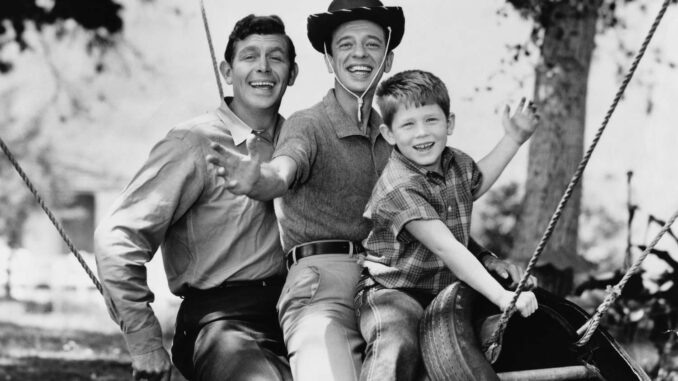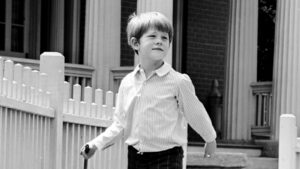
Introduction: What Made Mayberry Feel So Real?
Ever wonder why The Andy Griffith Show feels like a warm blanket from your childhood? Like it’s not just a show, but a place you could visit? There’s a reason for that. And it didn’t happen by accident. Ron Howard—Opie himself—recently opened up about a subtle yet powerful trick the creators used to make Mayberry feel alive, and it’s not what you’d expect.
Let’s take a walk down Main Street and uncover the real secret behind those unforgettable scenes.
The Timeless Charm of The Andy Griffith Show
A Slice of Americana in Black and White
Before color TV took over, Mayberry was already painting vivid pictures in viewers’ minds. Simplicity, warmth, and a little mischief—those were the ingredients. But there was more beneath the surface.
A Show That Slowed Down on Purpose
In an era that now favors fast cuts and explosive plot twists, The Andy Griffith Show took its sweet time. Conversations meandered. Pauses lingered. That wasn’t lazy writing—it was intentional.
Ron Howard’s Revelation: Stillness Was the Secret Sauce
“Silence Wasn’t Empty – It Was Full”
Ron Howard shared in an interview that Andy and the writers embraced silence. “They let the characters breathe,” Howard said. “They weren’t afraid of the quiet.” That might seem small, but it changed everything.
Creating Space for Emotion
Those still moments—the porch talks, fishing trips, and long glances—were deliberate. They allowed viewers to fill in the blanks with their own memories, hopes, and emotions.
Signature Scenes That Captured the Magic
Fishing by the Lake – More Than Just a Scene
Opie and Andy walking to the lake wasn’t just filler. It was a lesson. A vibe. A meditation on fatherhood and trust. And there was hardly any dialogue. That was the point.
The Porch as a Portal
The Taylor front porch is practically a character on the show. It hosted deep talks, lazy whistling, and unspoken understanding. According to Howard, this “porch culture” made viewers feel like they belonged there too.
The Unspoken Genius of Andy Griffith
Andy Knew When Not to Talk
Griffith himself was a master of restraint. While Don Knotts brought energy and gags, Andy anchored the show with calm. Ron revealed Andy would often cut his own lines during rehearsal if they felt unnecessary.
He Let Others Shine
Andy had the rare humility to let his co-stars take the spotlight. The stillness gave room for characters like Barney, Aunt Bee, and Opie to become fully realized.

Why This Approach Was Revolutionary for TV
Breaking the Rules of Sitcoms
In the ’60s, most comedies followed a laugh-a-minute formula. Griffith’s show defied that. It focused on rhythm, not just punchlines. And viewers didn’t just notice—they felt it.
Humanizing TV Characters
These quiet moments gave us real people, not caricatures. It felt like Andy wasn’t acting—he was Andy. Ron Howard said the natural flow made every interaction authentic.
Ron Howard’s Personal Takeaway
Learning to Write Through Stillness
Ron says this approach deeply influenced his own directing. Whether it’s Apollo 13 or A Beautiful Mind, Howard often uses quiet moments to deliver emotional punches.
Mayberry’s Lessons Stay With Him
“The show taught me that you don’t have to shout to be heard,” he said. That philosophy continues to shape his storytelling today.
The Role of Music and Ambience
Whistling That Said Everything
The theme song didn’t need words. That carefree whistle instantly transported viewers to a world without chaos. No lyrics, no fanfare—just simple, perfect tone.
Sound as a Storyteller
Ron noted how the sound design focused on less. Crickets at night. A creaking rocking chair. Distant dogs barking. All adding realism without overloading the senses.
A Visual Style That Matched the Mood
Long Takes and Soft Focus
Instead of fast cuts, scenes flowed naturally. Directors let moments unfold without rushing them. This allowed actors to be in the moment, not just hit marks.
Warm Lighting, Cozy Frames
Even when shot in black and white, the visuals felt warm. Framing was intimate—inviting you into the room, the conversation, the silence.
The Fans Felt It Too—Even If They Didn’t Know Why
A Show That Felt Like Family
You might not have noticed the silence consciously. But you felt it. It made Mayberry feel lived-in. Real. Like you could swing by and sit a spell.
Viewer Letters Confirmed the Magic
Ron shared that fans often wrote letters saying how “safe” the show felt. That was no accident—it was baked into every scene.
How the Technique Holds Up Today
Stillness in a Noisy World
In today’s fast-paced content landscape, The Andy Griffith Show is more refreshing than ever. It reminds us to slow down and pay attention.
Modern Shows That Borrow the Blueprint
Shows like Ted Lasso and This Is Us now use quiet, emotional beats in similar ways. The Mayberry legacy lives on.
Behind the Scenes: How They Made It Happen
Rehearsals Focused on Rhythm
Howard revealed that scenes were rehearsed with attention to pacing. They worked to make pauses feel natural—not awkward.
Editing for Emotion, Not Speed
Even in post-production, the editors chose to linger on a shot if it served the moment. Today’s editors could take a few notes.
What We Can Learn from Mayberry
In Storytelling, Less Can Be More
Sometimes, the loudest message is said in silence. The Griffith team understood that storytelling isn’t always about what’s said—it’s about what’s felt.
In Life, Presence Matters More Than Performance
Just like Andy didn’t need to overdo it, maybe we don’t either. Sometimes just being there—really there—is the whole point.
Conclusion: The Power of Quiet in a Loud World
So, the next time you hear that sweet whistle and see Andy and Opie walking toward the lake, remember—those signature scenes were crafted with intention. Thanks to Ron Howard, we now know the magic wasn’t in the action. It was in the inaction. The pauses, the porch talks, the stillness—they were the soul of Mayberry.
And in a world that constantly screams for our attention, maybe the real genius was in knowing when to whisper.
FAQs
1. What did Ron Howard say was the key to The Andy Griffith Show’s emotional power?
Ron Howard credited the show’s use of silence and still moments as a major factor. These quiet beats made scenes feel more genuine and emotionally impactful.
2. Why did Andy Griffith cut some of his own lines?
Andy often cut lines he felt were unnecessary, choosing instead to let the moment—and other characters—shine. This helped the show feel more authentic.
3. How did the show’s approach influence Ron Howard’s directing style?
Ron learned the value of subtle storytelling and emotional pacing. His films often use quiet moments to build deeper emotional arcs.
4. Why do fans still love The Andy Griffith Show today?
Its timeless values, relatable characters, and soothing pace make it a comforting escape. The intentional stillness helps it feel real and personal.
5. Are there modern shows that use similar techniques?
Yes! Shows like Ted Lasso, This Is Us, and even Stranger Things use quiet, emotional beats that echo Mayberry’s influence in today’s storytelling.
Let me know if you’d like this formatted for your blog, or need help turning it into a script or social media captions!
